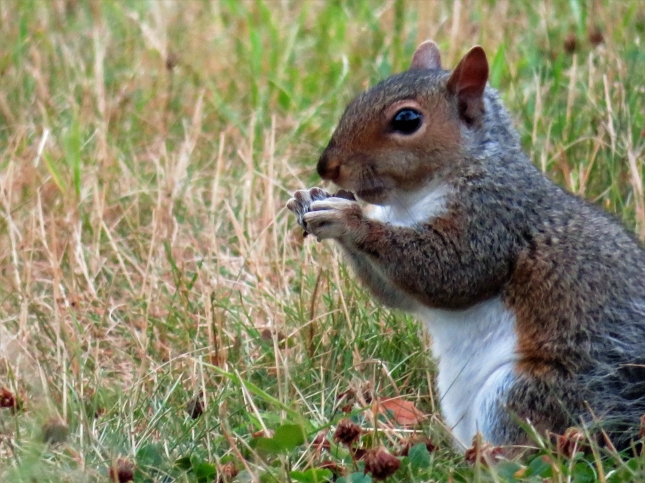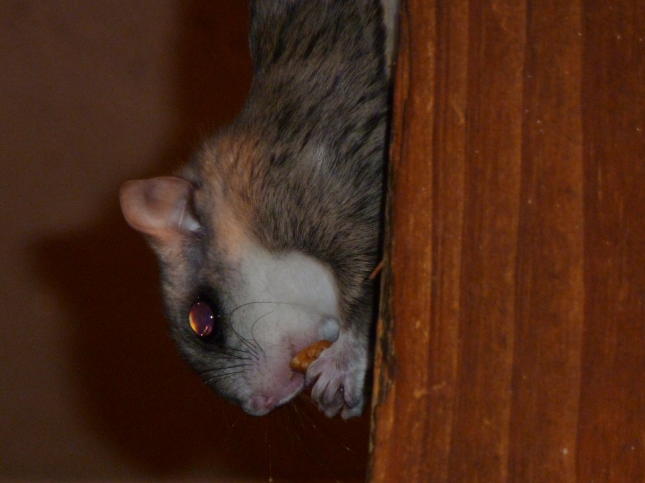Fun Facts About Squirrels
Long Island is home to two species of squirrels-the Easter gray squirrel and the Southern flying squirrel (rarely seen due to its nocturnal nature). Here are some facts about these entertaining critters.
Eastern Gray Squirrel

- Adult Squirrels can consume about one and a half pounds of seeds and nuts each week, which is roughly the equivalent of their own body weight.
- Squirrels’ favorite natural foods are hickory nuts, pecans, black walnuts, and acorns. Their favorite feeder food is black oil sunflower seeds, their least favorite feeder food is Nyjer® (thistle) seed.
- A 19-inch-long gray squirrel has a seven-foot-long digestive track that enables it to utilize a wide variety of foods including tree fruits, insects, bird eggs and mushrooms.
- Squirrels must drink water at least twice per day.
- A squirrel’s scalpel-sharp incisors grow about six inches per year. As with all the other members of the rodent family, squirrels must constantly gnaw on hard materials to keep them worn down and to sharpen them.
- In an hour’s time, a squirrel can collect and bury 25 nuts. Unable to remember each nut’s location, they find them again by using a highly developed sense of smell.
- During a harsh winter a squirrel may lose up to 25% of its body weight.
- Most squirrels are active in the winter only around mid-day, during the remainder of the year they are early risers with a peak activity period during the two hours after sunrise and again during the mid-afternoon.
- The name “squirrel” originates from the Greek words for shade and tail.
- Squirrels will have a litter of three to four young around early January and again in early August. The average life expectancy of these youngsters in the wild is approximately one year, although some captive squirrels have lived up to 15 years.
- Squirrels may den in the ground, tree cavities, and in nests they construct that are called dreys. Summer dreys are located in tree branches and consist of twigs and leaves. Winter dreys are waterproof and have a lining of bark, lichen, moss, fur and leaves.
- Squirrels can jump up to five feet vertically and eight feet between trees or structures. Placing feeders and baffles outside of their jumping range will help to deter them.
- The Gray Squirrel uses its tail as a shield when fighting, as a blanket in cold weather, and, sometimes, as an umbrella during rain storms.
- The Gray Squirrel weighs only ½ an ounce at birth and reaches its adult size six months later.
- The Gray Squirrel stocks its winter pantry by burying up to 10,000 nuts each fall. It also feeds on grapes, fungi, grasses, larval and adult insects, and amphibians.
Southern Flying Squirrel

- Flying squirrels do not actually fly. They glide through the air thanks to a furry, parachute-like membrane between its front and back limbs. This membrane is known as a "patagium" (plural: patagia). These membranes catch air as the squirrel falls, letting it propel itself forward instead of plummeting. In addition, to help the flying squirrel get to where it wants to get to, they also have cartilage spurs at each wrist that can be extended almost like an extra finger, stretching out the patagia farther than the squirrel's tiny arms could on their own.
- Depending on the air current, flying squirrels may glide 150 feet or more from a height of 60 feet. They can turn easily at right angles while gliding and control the direction of their glide by tensing and turning their legs and body and flapping their tail. As a flying squirrel approaches its landing, the squirrel flips its tail up and holds its body back to slow the glide down, giving the squirrel ample time to position its feet for grasping the tree trunk. Flying squirrels usually land face up and often run up the tree immediately after landing.
- Only two species of flying squirrel are native to the New World. Forty of the forty-three species world-wide are endemic to Asia.
- The two North American species are the Northern Flying Squirrel, and the Southern Flying Squirrel, which is the species found on Long Island.
- Mating occurs in late winter, and after a 40-day gestation period, an average of three to four young are born. A second breeding period occurs in the summer. The young are born blind and helpless but develop more quickly than other squirrels. By six weeks of age, they are able to forage on their own.
- Tree cavities and even bird houses may be used as nesting sites. The nest may be lined with shredded bark, leaves, moss, feathers, and other materials.
- Take a peek at your feeders at night...you just might see a special nocturnal visitor!
Photos: Stella Miller

